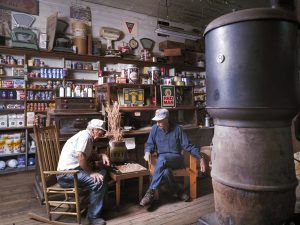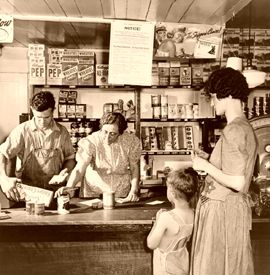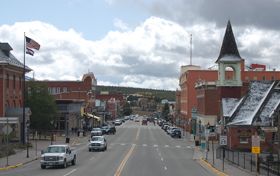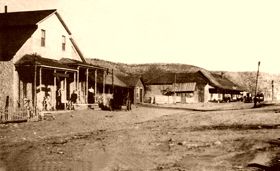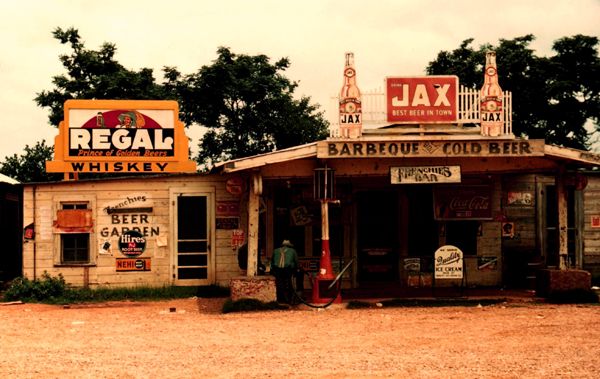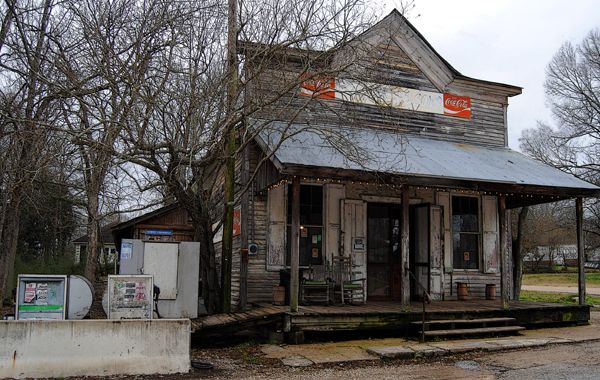
The Gibbes Store in Learned, Mississippi, began operations in 1899. Though the clientele and the merchandise have changed, stepping into this place is an adventure into the past. Photo by Kathy Alexander.
“There are more ducks killed around the stoves on the dry goods boxes at the customary haunts of local nimrods every evening between seven and nine-thirty o’clock than are slain in twenty-four hours along the Illinois River from source to mouth. Unless the legislature puts some restriction on this method of wholesale slaughter, the time will soon come when there won’t be any duck-shooting stories to tell — that anybody will put any confidence in.” — Correspondent in news notes to the Carrollton Patriot
Out of necessity, country stores, or general stores, started during the colonial period for the many pioneers who lived outside urban markets. Many owners of these mercantile began as roving peddlers. Once they had accumulated enough capital and inventory, they often established permanent locations in settlements with a need and likely profit. Others, however, would specifically move too quickly growing areas or crossroads, knowing that they would be successful. This was particularly true in boomtowns, such as mining camps or railroad towns. In many cases, the “peddler” and his “store” would move along to the next booming community if, and when, the boomtown and its profits declined. In many instances, the country store would be the first business in a new settlement, and sometimes, the town itself would take its name from the store itself. This was not necessarily because the area residents wanted it that way. When the number of area residents grew large enough, the post office was generally located in the General Store. And who was the potential postmaster that requested a post office and name? — The proprietor of that very same establishment. Sometimes, the owner was also the town clerk, served as Justice of the Peace, or even an undertaker.
In addition to often being the only provider of “store-bought goods” and the post office, the country store served other roles, including the community’s social center, as an “exchange bank,” community message center, and political club and forum for men in the community. One might find every type of notice somewhere in the store, on a door or a wall. These might include local events, elections, auctions, and “wanted posters” for outlaws.
While every store was different, there were similarities among many, including a front decorated by tin sign advertising, representing tobacco, cigars, soft drinks, hardware, and more. Usually, the store featured double doors that opened inward and windows filled with notions, jewelry, and other women’s items to entice them in. For the men, displays might show tools and boots.
When visitors entered the store, they were met with dim light, long counters, rounded glass showcases, and side walls lined with shelves, drawers, and bins. Other items such as buggy whips, horse harnesses, lanterns, pails, ropes, and more hung from the ceiling. Produce, nuts, beans, and nails were stored in bins, usually on the floor or against a wall. Shelves contained food stuff and fabric and sewing notions, household items, soaps, medicines, spices, crockery and dishes, cartridges and shells, and small farm implements. Generally, there were no side windows, contributing to the dark interior. If there was one, the post office was tucked into a corner or the rear of the store.
Sitting on the countertops, shoppers might find merchandise that included stacks of overalls, denim and khaki pants, candy jars, tobacco, and all manner of other products. Also sitting on the counter, one would usually see the cash register, a coffee mill, scales for weighing grocery items and nails, and a wrapping paper unit with string attachment. Virtually, the countertops would be filled with merchandise, leaving only enough room for purchases and wrapping of the items.
Between floor-to-ceiling shelves that lined the walls, and the multitude of items sitting atop and below the counters, visitors would find a pot-bellied stove surrounded by a couple of chairs, a coal bucket, the ever-present spittoon, and yes, a checkerboard sitting atop an empty nail keg. Elsewhere, in the narrow passageway that was the middle of the store, could be found barrels that might contain any number of items — from pickles to crackers, potatoes, mincemeat, and more candies.
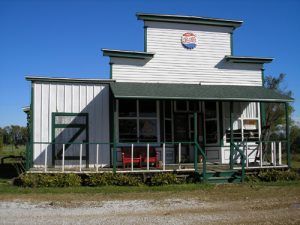
This old general store in Red Oak, Missouri, displays the typical white paint and a false front often seen in these old country stores, photo by Kathy Alexander.
The store was usually a two-story frame building, painted white and fronted by a raised porch for convenient loading and unloading. During warm weather, the porch also served as the social center as men gathered on a provided bench, chairs, or the steps, to talk about the weather, politics, the price of crops, and more. The upper floor was often only attic space, which served for supply storage. In cases where the second floor was an entire floor, it often served as the proprietor’s home. Reserve stock, fertilizer, livestock feed, and other heavy bulk items were stored in an extension at the side or rear.
For rural families, a weekly trip to the General Store was a social event come Saturday. With the kids sitting in the back of the wagon, along with chickens, cream, eggs, and pelts to be traded, Mom would pack a basket lunch and feed for the horses and make a day of the outing. Store-bought items were “luxuries” for most farm families and were rarely purchased except for need and maybe something special for Christmas. Entering the store with anticipation, they were met with the distinct aroma familiar in many country stores — a blend of ripe cheese, pickles, kerosene, produce, feed, cured meats, leather, and tobacco smoke.
Everyone looked around, perhaps picking out something they hoped for as a Christmas gift. The children pressed against the candy displays with eager smiles, featuring peppermint sticks, licorice, jelly beans, horehound, rock candy, lemon drops, and maybe some chocolate.
Boys looked longingly at Barlow knives, Stevens single-shot rifles, Jew’s harps, and harmonicas, while the girls wished and hoped for china dolls, “store-bought” dresses, glass beads, and pretty ribbons. Mom and Dad were more practical, perhaps sending wistful glances to new tools and glassware, but, in the end, they would leave with only what they needed. This might include basic staples such as flour, salt, coffee, some nails, chicken feed, a needle, and thread, and if the kids were fortunate, one piece of penny candy each. Rather than placing their articles in a bag, the clerk would wrap it all up in brown paper, tied up with twine.
Stocking of early stores required that the proprietor make trips to wholesale and auction houses, most of which were located in the northeast. Later, a growing number of traveling salesmen called “drummers” began to peddle their wholesale wares to store owners. With the expansion of the railroad, buying trips became much more convenient, and ordered wholesale goods could be sent by rail. To the townsfolk, the arrival of fresh merchandise became yet another social event, especially during the holidays when a merchant might stock items not seen during the rest of the year, such as crates of oranges, boxes of figs, and English walnuts.
The country store assumed a different significance in the South after the Civil War. Many stores were the outgrowth of the plantation system. When plantation owners owned slaves, they often had a commissary from which food and clothing were distributed to the slaves.
When the Civil War was over, the newly freed slaves often became sharecroppers or tenant farmers, and of course, had to pay for what they needed. The commissary might then become a “general store” that provided supplies on seasonal credit, often at exorbitant interest rates. Collateral for the credit was a crop lien where the merchant had a legal claim to future profits from harvests. During this time, the number of stores grew tremendously.
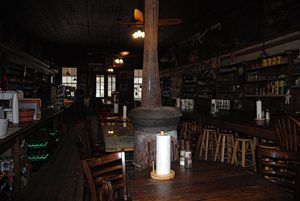
An old pot-belly stove heated most General Stores. The H. D. Gibbes & Sons country store in tiny Learned, Mississippi, still caters to local customers. Photo by Kathy Alexander.
Because there were so many sharecroppers and tenant farmers, one store owner sometimes couldn’t provide credit to all those who needed it in the area, so, in some small towns, its Main Street might be lined with several. This was the case in tiny little Learned, Mississippi, which never had a population of over a couple of hundred people. Looking eerily similar, four of these old buildings continue to stand in this small town, which now boasts only about 50 people. Three are closed, but one — H. D. Gibbes & Sons is still open, continuing to provide the basics to its customers, as well as serving up great steaks three nights a week. It is run by Chip Gibbes, the 5th generation owner, and the 7th generation of Gibbes in the area. The store was established in 1899.
In the post-Civil War South, these stores provided needed provisions to area customers. The lien system often placed the merchant at the center of class conflict, and the stores were sometimes condemned as having a monopoly. However, most of the time, the merchants themselves were often hard-pressed due to local competition, people unable to pay off their bills, and their creditors. When the proprietor tried to collect on debts owed, he was often attacked by the landlords, who contested the priority of their claims. They were also begrudged by the small farmers paying high-interest rates while trying to make a living in the fickle cotton market.
In other areas of the country, these small establishments made history in and of themselves. For example, in Leadville, Colorado, during the silver boom of the late 1870s, a small-time merchant named Horace Tabor, and his wife Augusta, made their way to the flourishing town to capitalize on the needs of the miners and many new residents. In the spring of 1878, Horace grubstaked two German prospectors. At this time, it was not uncommon in the many mining camps of the American West for merchants to supply funds or materials to prospectors for a promised share of the profits. Tabor provided the two miners with $17.00 in provisions that first day, and additional supplies on two more occasions, for a total of $54.00. The miners promised Tabor a one-third interest in any ore produced by their finds for the provisions. The German prospectors located a claim on Fryer Hill, which they named the Little Pittsburgh, and began to dig a shaft.
On April 15, 1878, Tabor’s generosity hit pay dirt when the two miners — August Rische and George Hook, announced to Tabor that they had found silver at what would become the Little Pittsburgh Mine. By July, nearly a hundred tons of ore had been taken from the mine, and each of the three partners had an income of $50,000 a month. In the fall, Hook sold out to Tabor for $98,000. Later, August Rische sold his interest to Jerome Chaffee and David Moffat for over a quarter of a million dollars.
In the end, Horace Tabor, who earned the moniker of the “Silver King,” became extremely wealthy and influential. He briefly served as a U.S. Senator and began a “fling” with a younger woman named “Baby Doe.” He left his wife, married Baby Doe, and ultimately lost his fortune, resulting in the rags to riches story of the Tabor Triangle.
Another interesting tale of a general store occurred in Lincoln, New Mexico. Because of the importance of these stores, they often became monopolies, and the greed of the store owner sometimes capitalized on the needs of the area residents. This was the case of the Murphy & Dolan Mercantile in the south-central frontier town of Lincoln. In the early 1870s, Lawrence Murphy and James Dolan owned the only store in Lincoln County, which, at the time, was the largest county in the nation, covering 1/5 of New Mexico
territory. The pair, who also owned large cattle ranches and had influential territorial ties to officials in Santa Fe, controlled the region. In 1877, a couple of “upstarts” named Alexander McSween and John Tunstall had the gall to set up a rival business, which erupted in what is known as the Lincoln County War. This frontier “range war” set none other than Billy the Kid on his short-lived but well-known life as an outlaw.
These are but a couple of interesting tales involving old general stores. If walls could talk, there would be dozens more.
In most country stores, advertising wasn’t a primary focus, prompting one storekeeper to say, “Advertising don’t take the place of dustin.'” However, many a store might give away paper fans or yardsticks with their name printed on them. Advertising became important to manufacturers, especially in the late 19th century as they began to brand their products. At that time, old country stores began to display all types of signs, calendars, lights, fixtures, and even murals on the sides of their buildings advertising soft drinks, tobacco, farm implements, and more.
Other things began to change for the old General Store at about the same time. In 1896, the postal service offered Rural Free Delivery (RFD), cutting down on the number of trips made to the post office, which is often inside the general store. The new rural delivery also opened the door for rural customers to receive merchandise catalogs from mail order companies such as Montgomery Wards, founded in 1872, and Sears, founded in 1893. Catalogs kept rural families up-to-date on the latest goods, featuring all manner of merchandise from dry goods to canned vegetables. When their products arrived, they were delivered to the local storekeeper in many cases. Alarmed merchants began to call the mail-order catalogs “town killers.”
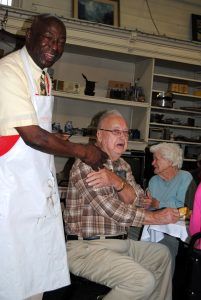
The old country store in Lorman, Mississippi, has turned restaurant. Owner-Operator Arthur Davis serves up some great old-fashioned fried chicken and entertains customers with his songs of his grandma’s cornbread. Great fun!! Photo by Kathy Alexander, 2013.
Mail delivery to rural areas also meant that the government built new and better roads. When automobile travel began, people began to go to bigger cities to shop at a greater number of more competitive merchants. In the 1930s, supermarkets began to spring up, and gradually, and unable to compete, general stores began to close.
Today, few places can evoke pleasant nostalgic memories among old-timers, like the old-fashioned general store. Many remember, with great fondness, the family shopping trips, penny candies, and the shared trading of philosophy around the pot-belly stove in the winter or sitting upon the broad porch in the summer. Among other focal points of a small town, such as the school, church, and courthouse, the country store was the lifeblood of the community.
Of the hundreds of old stores like these, only a fraction remain, and, of those, most serve as museums, antique shops, and tourist attractions. However, that is not always the case. Though they have adapted to changing needs, primarily as “convenience stores,” without the look of today’s ugly modern convenience stores, there are many that continue to play the role that they always have, offering everything from canned goods to gasoline, to farming equipment.
© Kathy Alexander/Legends of America, updated December 2021.
Also See:
Western Style Decor (Ideas from Legends’ General Store)

